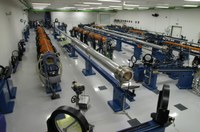The Prague Asterix Laser System (PALS) provided first kJ pulses in Prague 20 years ago
In the late nineties, a unique terawatt iodine (1315.2 nm) laser system Asterix IV [1], originally developed, built and operated at the Max Planck Institute of Quantum Optics in Garching near Munich, was moved to Prague. In the Slovanka campus belonging to the Czech Academy of Sciences, a new building was erected to host the iodine laser system as a key experimental facility of the PALS (Prague Asterix Laser System) Research Centre, a joint laboratory between the Institute of Plasma Physics and the Institute of Physics of the Czech Academy of Sciences. On Thursday, 8th June 2000, the iodine laser facility provided the first kilojoule sub-nanosecond pulses under the new name - PALS [2].
A few years ago, a new Ti:Sapphire laser system providing ultra-short (1.2J@40fs) pulses was developed and placed in the main building of the Centre. The beams of these two laser systems can be combined in space and time [3] thus creating an opportunity for sophisticated pump-and-probe experiments in a system of cylindrical and spherical vacuum interaction chambers. In addition to that, both lasers can drive various secondary sources of energetic photons and charged particles for irradiation and pump-and-probe experiments with short and ultra-short pulses of laser and ionizing radiation. The PALS Research Centre is a founding member of the LASERLAB-EUROPE Consortium. A part of the research program of the Centre falls into the keep-in-touch activities in the field of inertial fusion coordinated by the Inertial Fusion Energy Working Group of EURATOM.
At the PALS Research Center, the main research field is focused on a creation and probing of dense plasmas using the above mentioned radiation sources. The research program concentrates on the role of fields and particles in dense plasmas. In the Center, strong magnetic fields [4] and electromagnetic pulses (EMP effects) [5], charged particles acceleration [6,7], and laser-plasma interaction phenomena [8,9] are studied. In addition to the fundamental studies in plasma physics, the motivation comes also from inertial confinement fusion [10,11], laboratory astrophysics, planetology and astrobiology [12-14], materials processing and damage studies [15], and other fields of science and technology. In the future, the PALS researchers intend to concentrate on experiments benefiting from the extremely narrow line of the gas laser.
A jubilee workshop “Iodine Lasers and Applications” – originally planned to be held in Prague in June 2020 – will be postponed to the autumn/winter because of the Covid-19 situation. A more detailed information on the planned event will be released in summer.
More information on the facility can be found on its webpage: www.pals.cas.cz
Selected publications:
- H. Baumhacker et al.: Layout and performance of the Asterix IV iodine laser at MPQ, Garching, Appl. Phys. B 61, 325 (1995), DOI:10.1007/BF01081531
- K. Jungwirth et al.: The Prague Asterix Laser System, Phys. Plasmas 8, 2495 (2001), DOI: 10.1063/1.1350569
- J. Dostál et al.: Synchronizing single-shot high-energy iodine photodissociation laser PALS and high-repetition-rate femtosecond Ti:sapphire laser system, Rev. Sci. Instrum. 88, 045109 (2017), DOI: 10.1063/1.4979810
- T. Pisarczyk et al.: Magnetized plasma implosion in a snail target driven by a moderate intensity laser pulse, Sci. Rep. 8, 17895 (2018), DOI: 10.1038/s41598-018-36176-8
- J. Krása et al.: Effect of expanding plasma on propagation of electromagnetic pulses by laser-plasma interaction, Plasma Phys. Control. Fusion 62,025021 (2020), DOI: 10.1088/1361-6587/ab5c4e
- V. Horný et al.: Short electron bunches from injection by perpendicularly crossing pulses, Plasma Phys. Control. Fusion 61, 085018 (2019), DOI: 10.1088/1361-6587/ab2728
- M. Šmíd et al.: Characterization of suprathermal electrons inside a laser accelerated plasma via highly-resolved Kα-emission, Nature Commun. 10, 4212 (2019), DOI: 10.1038/s41467-019-12008-9
- G. Cristoforetti et al.: Time evolution of stimulated Raman scattering and two-plasmon decay at laser intensities relevant for shock ignition in a hot plasma, High Power Laser Sci. Eng. 7, 1 (2019), DOI: 10.1017/hpl.2019.37
- J. Limpouch et al.: Characterization of residual inhomogeneities in a plasma created by laser ionization of a low-density foam, Plasma Phys. Control. Fusion 62, 035013 (2020), DOI: 10.1088/1361-6587/ab6b4d
- L. Giuffrida et al.: High-current stream of energetic alpha particles from laser-driven proton-boron fusion, Phys. Rev. E 101, 013204 (2020), DOI: 10.1103/PhysRevE.101.013204
- D. Batani et al.: Progress in understanding the role of hot electrons for the shock ignition approach to inertial confinement fusion, Nucl. Fusion 58, 032012 (2019), DOI: 10.1088/1741-4326/aaf0ed
- M. Ferus et al.: Prebiotic synthesis initiated in formaldehyde by laser plasma simulating high-velocity impacts, Astron. Astrophys. 626, A52 (2019), DOI: 10.1051/0004-6361/201935435
- M. Ferus et al.: Main meteor spectral features studied using terawatt-class high power laser, Astron. Astrophys. 630, A127 (2019), DOI: 10.1051/0004-6361/201935816
- P. B. Rimmer et al.: Identifiable acetylene features predicted for young Earth-like exoplanets with reducing atmospheres undergoing heavy bombardment, Astrophys. J. 888, 21 (2020), DOI: 10.3847/1538-4357/ab55e8
- V. Vozda et al.: Detachment of epitaxial graphene from SiC substrate by XUV laser radiation, Carbon 161, 36 (2020), DOI: 10:1016/j.carbon.2020.01.08


